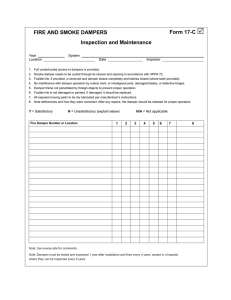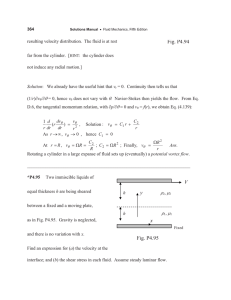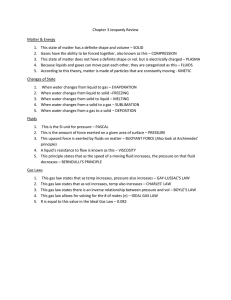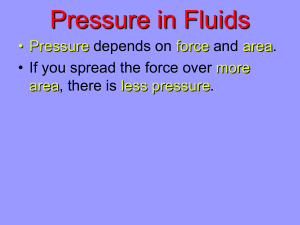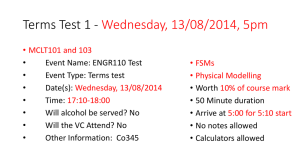Research Journal of Applied Sciences, Engineering and Technology 2(2): 159-163,... ISSN: 2040-7467 © M axwell Scientific Organization, 2010
advertisement
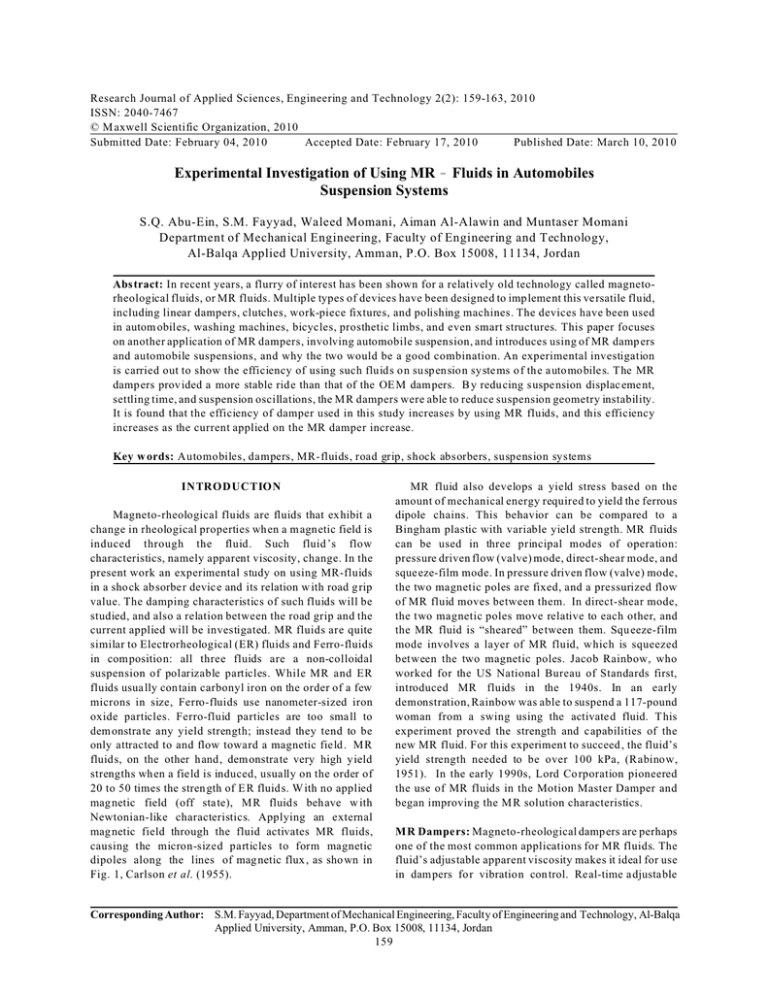
Research Journal of Applied Sciences, Engineering and Technology 2(2): 159-163, 2010 ISSN: 2040-7467 © M axwell Scientific Organization, 2010 Submitted Date: February 04, 2010 Accepted Date: February 17, 2010 Published Date: March 10, 2010 Experimental Investigation of Using MR ! Fluids in Automobiles Suspension Systems S.Q. Abu-Ein, S.M. Fayyad, Waleed Momani, Aiman Al-Alawin and Muntaser Momani Department of Mechanical Engineering, Faculty of Engineering and Technology, Al-Balqa Applied University, Amm an, P.O. Box 15008, 11134, Jordan Abstract: In recent years, a flurry of interest has been shown for a relatively old technology called magnetorheological fluids, or MR fluids. Multiple types of devices have been designed to implement this versatile fluid, including linear dampers, clutches, work-piece fixtures, and polishing machines. The devices have been used in autom obiles, washing machines, bicycles, prosthetic limbs, and even smart structures. This paper focuses on another application of MR dampers, involving automobile suspension, and introduces using of MR damp ers and automobile suspensions, and why the two would be a good combination. An experimental investigation is carried out to show the efficiency of using such fluids on suspension syste ms of the a utomobile s. The MR damp ers provided a more stable ride than that of the OE M dam pers. B y redu cing suspe nsion displac eme nt, settling time, and suspension oscillations, the M R dampers were able to reduce suspension geometry instability. It is found that the efficiency of damper used in this study increases by using MR fluids, and this efficiency increases as the current applied on the MR damper increase. Key w ords: Automobiles, dampers, MR-fluids, road grip, shock absorbers, suspension systems INTRODUCTION Magneto-rheological fluids are fluids that exhibit a change in rheological properties when a m agnetic field is induced through the fluid. Such fluid ’s flow characteristics, namely apparent viscosity, change. In the present work an experimental study on using MR-fluids in a shock ab sorbe r device and its relation w ith road g rip value. The damping characteristics of such fluids will be studied, and also a relation between the road grip and the current applied will be investigated. MR fluids are quite similar to Electrorheological (ER) fluids and Ferro-fluids in com position: all three fluids are a non-colloidal suspension of polarizable particles. While MR and ER fluids usually contain carbonyl iron on the order of a few microns in size, Ferro-fluids use nanometer-sized iron oxide particles. Ferro-fluid particles are too small to dem onstrate any yield strength; instead they tend to be only attracted to and flow toward a magnetic fie ld. M R fluids, on the other hand, demonstrate very high y ield strengths when a field is induced, usually on the order of 20 to 50 times the stren gth of E R fluid s. W ith no applied mag netic field (off state), M R fluid s behave w ith Newtonian-like characteristics. Applying an external mag netic field through the fluid activates MR fluids, causing the micron-sized particles to form magnetic dipoles along the lines of mag netic flux , as sho wn in Fig. 1, Carlson et al. (1955). MR fluid also develops a yield stress based on the amount of mechanical energy required to yield the ferrous dipole chains. This behavior can be compared to a Bingham plastic with variable yield strength. MR fluids can be used in three principal modes of operation: pressure driven flow (valve) mode, direct-shear mode, and sque eze-film mode. In pressure driven flow (valve) mode, the two magnetic poles are fixed, and a pressurized flow of MR fluid moves between them. In direct-shear mode, the two magnetic poles move relative to each other, and the MR fluid is “sheared” be tween them. Squ eeze-film mode involves a layer of MR fluid, which is squeezed between the two magnetic poles. Jacob Rainbow, who worked for the US National Bureau of Standards first, introduced MR fluids in the 1940s. In an early demonstration, Rainbow was able to suspend a 117-pound woman from a swing using the activated fluid. T his experiment proved the strength and capabilities of the new MR fluid. For this experiment to succeed , the fluid’s yield strength needed to be over 100 kPa, (Rabinow, 1951). In the early 1990s, Lord Co rporation pioneered the use of MR fluids in the Motion Master Damper and began improving the M R solution characteristics. M R Dampers: Magneto-rheological dampers are perhaps one of the most common applications for MR fluids. The fluid’s adjustable apparent viscosity makes it ideal for use in dampers for vibration con trol. Real-time adjustable Corresponding Author: S.M. Fayyad, Department of Mechanical Engineering, Faculty of Engineering and Technology, Al-Balqa Applied University, Amman, P.O. Box 15008, 11134, Jordan 159 Res. J. Appl. Sci. Eng. Technol., 2(2): 159-163, 2010 Fig. 1: Off-state MR fluid particles (left) aligning in an applied magnetic field (right) Fig. 2: Monotube MR damper, section view Fig. 3: Twin tube MR damper, section view systems can be developed to change damping based on certain physical measureme nts, such as velocity or acceleration, in order to better counteract and control the system dynamics. Typically, MR damper applications use the pressure driven flow (valve) mode of the fluid or a combination of valve mode and direct-shear mode. Dam pers that use only d irect-she ar mo de tend to be used in applications that do not require much force from the damp er. Linear M R dam pers can be of three primary designs: mon otube , twintube, or double-ended (also known as through-tube). The three design types reflect methods of adjusting the fluid volume to account for the volume of the damper shaft. Monotube designs are the most common dam per de sign; the y exh ibit simplicity and compactness of design and with the ability to be mounted in any orientation (Fig. 2). The twintube damper uses inner and outer cartridges to negotiate the changing volume of MR fluid, as shown in Fig. 3. As the piston rod enters the inner housing, the extra volum e of M R fluid displac ed by the piston rod is forced from the inner housing to the outer housing via the foot valve. When the piston rod retracts, MR fluid flows back into the inner housing, therefore preventing the creation of vacuum in the inner housing and cavitations of the dam per. D rawback s of this design include size and orientation – this damper must be mounted with the foot valve at the bottom to ensure no cavitations (Lampe, 1998). Double-ended (through-tube) dampe rs use a third method to account for the piston rod volume. Fully extended, the piston rod protrudes through both sides of the damper housing, as shown in Fig. 4. This method of damper design retains a co nstant piston ro d and fluid volume within the housing, thereby eliminating the need for a second housing or accum ulator. 160 Res. J. Appl. Sci. Eng. Technol., 2(2): 159-163, 2010 Fig. 4: Double-ended (Through-Tube) MR damper, section view Table 1: Damper specifications Maximum Input Power Fluid M aximum Yield Stress M ax a ppa rent F luid P lastic V iscos ity Wire length, Diameter Coil Turns Inductance (L) C o il R es is ta n ce (R ) The twintube and double-ended damper provide a significant advantag e over the monotube design. The pressurized charge in the accumulator of the monotube design adds a spring force to the damp ing rod , so not only does the dam per ha ve forc e vs. velocity characteristics, it also has a spring rate. The twintube and double-ended damp er, however, do not dem onstrate this trait, showing only force vs. velocity characteristics. Many researches discussed the operation and applications of the MR fluids in shock absorbing, Ericksen et al. (2003), presented a theoretical and experimental investigations of a controllable, semi-active, fail-safe, Magneto-Rheological Fluid (MR F) shock absorber for the rear suspen sion of an off-road motorcycle. A fail-safe MR F damper is referred to a device that retains a minim um re quired dam ping c apac ity in the event of a power supply or electronic system failure. A theoretical fluid mechanics-based model was developed to predict the controllable damp ing force in terms of the physical parameters of the device, the magnetorheological fluid properties, the electroma gnetic circuit parameters, and the input motion. It was found that the MR F damper emulated the original equipment manufacturer shock absorber performance in its passive off mod e (i.e., no applied magnetic field) and provided controllable dynamic damping rebound and compression forces, wh en activated (E ricksen, 1999). Magnac et al. (2006 ), presented a device-oriented test bench developed in order to characterize the magnetomechanical properties of MRF such as the magnetization curve, the yield stress. It was based on a large electromag net, which is ab le to produce a magnetic field into a tube containing the MR F sample. The magnetization curve is determined using the permeameter method. It allows designing the magnetic circuits for applications. The variable damping versus field was measured using a dynamic method. The yield stress is measured using various static loads. It allows desig ning devices with the right braking/holding forces in the applications. 50W 35.87kpa 2.58 pa/s 200 m, 0.7 mm 200 2.5 mH 2.75 S MATERIALS AND METHODS In this work The MR fluid damper, which was used, is the twintube damper shown in Fig. 3. The effective fluid orifice is the entire annular space between the piston outside diameter and the inside of the damper cylinder housing. Movement of the piston causes fluids to flow through this annular region. T able 1 shows the used dam per specifications. M R fluid used in this study is of an own composition. MR is com posed o f: C C C Iron particles: iron powder is used as a m agnetic particles which have less than 4 microns diameter and this ra nge of siz e is c onsidere d perfe ct for MR fluids. Oil: the oil is needed to be used w ith lithium grease because it contains the additives that prevent iron particles from settling, hydrocarbon oil or the automotive oils cannot be used because it has high viscosity and the M R fluid will be M R grease rather than MR fluid. Also, the WD-40 oil can't be used too, although it has a low viscosity but it has a strong odor and it is more volatile and it evaporates quickly. Grease: The role of lithium grease, which contains some chemicals, is to prevent iron particles from settling; the viscosity is measured using the viscometer. The three immersion bodies have different factors giving different scale ranges. The viscometer can be used to measure both Newtonian and non-Newtonian liquids. The measured viscosity for the MR fluid is approximated as about 0.2 6 Pa.s G1 . Wor k procedure: The laboratory testing was accomplished via the use of a Suspension system Test 161 Res. J. Appl. Sci. Eng. Technol., 2(2): 159-163, 2010 Fig. 5: Damping characteristic for MR damper at off-state Fig. 6: Damping characteristic for MR damper at 0.5A Fig. 7: Damping characteristic for MR damper at 1A machine, which can provide a variety of types of displacement inputs from im pulses and square waves to sinusoidal waves. The Suspension test machine was set to input a sinusoidal wave of a varying frequencies and displacement into the dam per via a hyd raulic actuator. The clamping system on the machine also incorporates a load cell, which outputs a voltage proportional to the force of the damper. Test procedure was kept the same for both the OEM and MR dam pers. A sinusoidal displacement input was used to excite the dampers. Frequency of the sine wave was at 2-20 Hz, while the displacement was varied from 0 to 1.6 inch, providing a range of velocities at which to collect force data. Since the input is a sinuso idal wave in the form of Eq. (1), the maximum velocity can be determined via its derivative, as show n in Eq. (2): X = A sin Tt dx/dt = Aw cos Tt Road Grip: The road grip is a concept used to give an indication about the efficiency of the dam ping system in the autom obiles; it depends on the amount of obstacles or status of the road used by the automo bile. RESULTS AND DISCUSSION MR -fluids performance depending actually on two parameters: the value of the applied current, and the composition or ratios of added materials to the oil. In this study the effects of applied current is investigated at some specific value of road grip and the damping characteristics will be draw n to show the best current offer the best dam ping a nd road grip . The Mo tor scan suspension tester mod.2210 was used to incorp orate the required results. Motor scan suspension tester is used to test the suspension of the cars objectively and quicker than that was until now. The suspension is put into a vibration of 25 Hz. At the mo men t that this frequency is reach ed, the engin e is stopped and the frequency will slowly go back to 0 H z. Figure 5 shows the damping characteristics for off-state of the M R-dam per. It is clear tha t the road grip at this condition is about 8%. Figure 6 shows the road grip of about 9% when a current of about 0.5 A affects on the M R damp er, it is also clear that the efficiency of the damper has been improved. (1) (2) whe re x: is the dampe r displac eme nt, dx/dt is the damper velocity, A is: the amp litude of the sine wave,T : is the angular velocity, and t: is the time. The maximum veloc ity is AT, and the maximum force is at that displacement setting is attributed to the maximum velocity. 162 Res. J. Appl. Sci. Eng. Technol., 2(2): 159-163, 2010 Fig. 8: Damping characteristic for MR damper at 1.5A Fig. 9: Damping characteristic for MR damper at 2A the applied curre nt is zero and increases as the current in the coil increases. The experimental results have shown that the damper sinusoidal response using PWM voltage has a very fast response about 7 ms, using the low carbon steel. REFERENCES Carlson, J.D. and K.A. St. Clair, 1955. Commercial Magneto-Rheological Fluid D evices. Proc. the 5th International Conf. on ER Fluids, MR Suspensions and Associated Technology, Sheffield, UK, pp: 20-28. Ericksen, E.O. and F. Gordaninejad, 2003. A magnetorheological fluid shock ab sorber for an off-road motorcycle. Int. J. Vehicle Des., 33(1-3): 139-152. Ericksen, E.O ., 1999. Stud y of M agnetorhe ological Fluid (MRF) dampers and development of a MRF shock absorber for a motorcycle. Master’s Thesis, Department of M echa nical E ngine ering, U niversity of Nevada, Reno. Lampe, D., 1998. MRF-overview Actuator ’98, from materials database on com merc ially ava ilable Electro- and Magnetorheological Fluids (ERF and MRF). Magnac, G., P. M enero ud, M .F. Six, G . Patient, R. Leletty and F. Claeyssen, 2006. Characterization of magneto-rheological fluids for actuators applications. Actuator 2006, 10th International conference on new actuators, 14 – 16 June 2006, Bremen, Germany. Rabinow, J., 1951. M agnetorhe ological Fluid. U.S. Patent No. 2,575,360. Fig. 10: Road grip vs. current applied on the MR damper Figure 7 - 9 show the damping characteristics of the MR dam per statu s with different values of applied currents. Also the road grip of the damper is increased proportiona lly with the applied current, it reaches about 21% at 2 A curren t. Road grip is proportional to the current applied on the MR damp er as sh own in Fig . 10. CONCLUSION The damping ratio . is considered as an indication of the system ch aracteristics and the system behavior, if it’s under, critically, or over damped. The best characteristics of a second order system as the present system are about 0.7. The steady state resp onse was shown in both sinusoidal displac eme nt and velocity, wh ich varies with the applied current and attain its maximum value when 163
